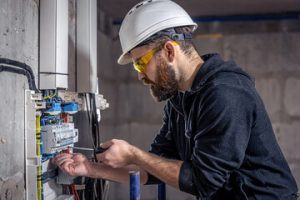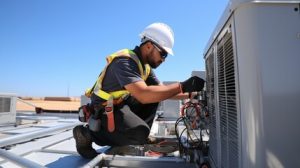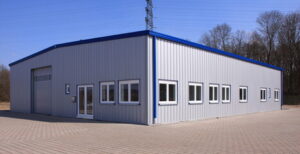Handymen provide a one-stop solution for small repair and maintenance tasks. They are less expensive than specialized contractors and do not need a license.

Handymen rely on time-tested hand tools. A reliable tape measure, screwdrivers, and pliers are essential. Add a stud finder to locate electrical wiring and prevent wall damage. Wire cutters are also helpful for safely cutting different gauges of wire. Contact J&R Construction for professional help.
Electricians specialize in installing, repairing, and maintaining electrical systems in homes and businesses. They use their extensive knowledge of wiring, circuits, and lighting to ensure that all work is up to code and safe for the public to use. Electricians also frequently troubleshoot issues with equipment or appliances, making them a vital part of the maintenance team for many facilities.
A certified electrician can handle a wide range of projects, including upgrading outlets and switches, installing ceiling fans, and replacing light fixtures. In addition, electricians can also install and repair smoke detectors and perform safety inspections to make sure that the home’s electrical system is up to date.
Some electricians choose to focus on industrial settings, where they may need to interpret complex schematics for robotics and automation systems. They are often on-call to fix power outages and other emergencies, working in factories, hospitals, and other demanding environments that require specialized training, PPE, and strict compliance with safety protocols beyond what is standard for residential electrical services.
Commercial electricians install and maintain energy-efficient systems in offices, schools, restaurants, and other commercial spaces. They may also be responsible for interpreting blueprints, laying out wiring systems, and ensuring that everything is compliant with local codes and regulations for commercial properties.
Handymen should avoid working on any electrical systems, as their knowledge is limited to the basic tasks that they can do without risking injury or fire. For example, it is not safe for a handyman to replace a light bulb unless they know how to safely turn off the electricity to the fixture. Moreover, unlicensed electrical workers are not familiar with all of the necessary rules and regulations that govern home electrical systems, and any problems they cause could be a major safety hazard. This is especially true if they try to sell their services later on, as a buyer may notice the shoddy work and refuse to buy the property. This is why it’s important to find a licensed and insured electrician.
Plumbers
Plumbing is an important aspect of any home, and having a properly functioning waste and water system can greatly improve the comfort and safety of a building. Plumbers are experts in their field, and are trained to address any issue related to pipes or plumbing fixtures. If you have a plumbing problem, it is crucial to find a plumber near you and call them right away to fix it. A plumber can save you time, money, and stress by fixing your plumbing issues quickly.
Licensed plumbers offer a wide range of services, from routine maintenance to plumbing repairs and replacements. They are also able to repair and install a variety of fixtures, such as sinks, faucets, and garbage disposal units. In addition to plumbing, handymen can also perform basic electrical work, such as replacing light bulbs and switches, and are often able to help with small home improvement projects.
Some common plumbing problems that handymen can assist with include leaky faucets, running toilets, and clogged drains. Leaky faucets can waste a lot of water and increase your water bill, while running toilets can be a major nuisance. Handymen can easily fix these minor plumbing problems by tightening or replacing faulty parts, and they are also skilled in repairing water heaters.
Depending on the complexity of the plumbing issue, it may be more cost-effective to hire a professional plumber than a handyman. Licensed plumbers are able to provide you with expert advice and quality workmanship, which is essential for ensuring that your plumbing problem is fixed correctly. In addition, they have the necessary tools and equipment to get the job done quickly and efficiently.
Before hiring a handyman, make sure to ask them about their qualifications and experience. You should also ensure that they are licensed and insured, and have references from previous clients. Lastly, it is important to have clear communication with the handyman about the job that needs to be done. This will help avoid any misunderstandings and ensure that the job is completed successfully. Additionally, you should always be prepared for the arrival of a handyman, by clearing the area and moving any furniture that could block access to the work area.
Painters
Handymen who offer painting services can help their clients revamp the look of their homes. This popular home improvement project can increase a homeowner’s curb appeal and boost property value. It can also be a lucrative addition to a handyman’s service offerings. Painters can help their customers choose the right colors for their homes and ensure that the job is done correctly.
Painting services can include interior and exterior painting, touch-ups, and staining. They can also apply baseboards and trim and apply crown molding. They can also repair scuff marks and other damage. Adding painting to a handyman’s portfolio can help them expand their business and attract new customers.
Many homeowners want to add more color to their living spaces, but don’t have the time or skills to do so themselves. Painting is a complex task that can be difficult to get right. Fortunately, handymen can tackle this task quickly and efficiently, saving their customers time and money.
Some painters specialize in specific genres of art. They may focus on landscape, still life, portraiture, abstract, or contemporary art. They also create commissioned works for individuals or businesses. In addition to creating artwork, painters often exhibit and sell their work at galleries, museums, or other exhibition spaces.
Painters can also provide a wide range of home improvement services, including flooring installation. This is a great way to attract new customers and improve the quality of a home. They can also assist with door repairs and other maintenance tasks.
Another important service handymen can offer is light fixture installation. This can make a huge difference in a room’s aesthetic and functionality. They can also install window coverings and provide consultation on selecting the best type for a particular room or space. They can even replace outdated fixtures with more energy-efficient options. This can significantly reduce a household’s electricity bill. Handymen can also help with other home improvement projects, such as repairing and installing fences or gates. They can also perform general maintenance tasks, such as patching drywall and fixing leaks. This can save customers a lot of time and effort and prevent costly repairs down the road.
Furniture Assembly
Furniture assembly requires a high level of attention to detail and knowledge of how different pieces of furniture fit together. It also involves careful handling of delicate materials. Professional handymen have the experience and tools to handle this type of job safely and efficiently. In addition, they can identify potential issues and take steps to mitigate them. This prevents costly repairs and saves money in the long run.
The first step in successful furniture assembly is to thoroughly read the instruction manual. This will help you understand the logic behind the instructions and make them easier to follow. The instructions are often written in a visual language that uses exploded diagrams and minimal text. Using varying line weights to represent different parts or actions will help you avoid confusion. Arrows, numbered steps, and close-up views will also help you navigate the process.
Next, set up your work area and clear the area to ensure that you don’t lose any parts or damage your furniture. It’s also a good idea to label and organize any leftover parts or tools so that you can easily find them later. Finally, assemble the piece of furniture and tighten all screws in the correct sequence. This will prevent warping and ensure that the piece fits together perfectly.
While some furniture pieces can be put together with basic tools, it’s important to have specialized tools for assembly. These tools are expensive and may not be available in your home, so hiring a professional can save you money in the long run. Additionally, it will help you save time and energy by avoiding common mistakes like putting together crooked or wobbly furniture.
Aside from saving you time, professional assemblers can also help you avoid injuries and damage to your furniture. They are familiar with the proper techniques and safety precautions, so they can safely and quickly assemble any type of furniture. In addition, they can assemble furniture that is tailored to your needs and preferences, making it a more personalized and functional investment. Additionally, they can help you save on repair costs by identifying potential issues before they become serious problems.


